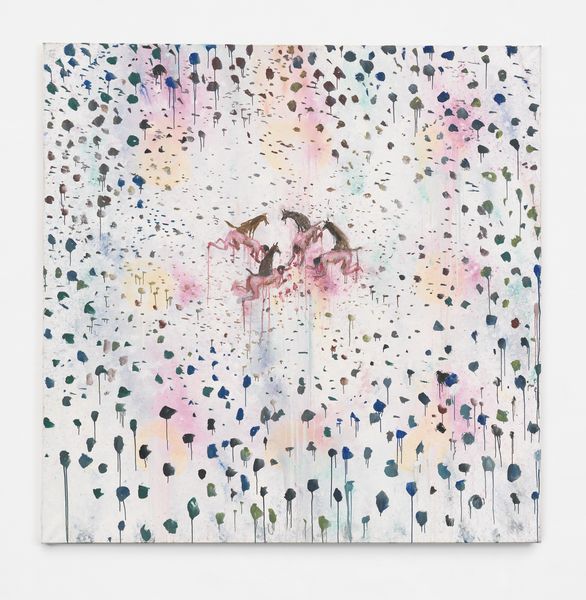Philippe Vandenberg at Hauser & Wirth London reviewed by ARTFORUM

Installation view, 'Philippe Vandenberg. Selected Works', Hauser & Wirth London, England, 2013 © Estate Philippe Vandenberg. Courtesy the Estate Philippe Vandenberg and Hauser & Wirth. Photo: Alex Delfanne
Philippe Vandenberg at Hauser & Wirth London reviewed by ARTFORUM
Mysterious figures – naked primitive men surrounded by animals (horned bulls, wolves, lions, donkeys) – populate the terrain of his dark, painterly landscapes. For instance, in ‘D’après ‘l’Ennemi intérieur’’ (‘After ‘The Enemy Within’’), 2003, on an unevenly painted and repainted ground – white, with a very faint pastel-hued haze of yellow, pink, blue, and green – a group of four men on their hands and knees are surrounded by a field of dripping black, green, and blue paint daubs.
Leering hounds lie on their backs, completing a scene that seems a kind of pagan ritual shot through with black humor. Several of the works feature lyrical statements scrawled onto their surfaces; ‘NOW PATIENCE IS FLOWERING INTO DEATH,’ for instance, reads ‘La faim de l’âne, la fin de l’âme’ (‘The Hunger of the Donkey, the End of the Soul’), 1999–2000. The paintings in this, Vandenberg’s first solo show in the UK, were selected by the artist’s daughter Hélène Vandenberghe.
Based on these examples, her father, who was born in Ghent, Belgium, in 1952 and died in Brussels in 2009, could easily be described as a neo-expressionist. His paintings, however, access an existential passion that seems absent from the romanticism of his peers in that movement. In fact, Vandenberg’s scenes seem closer in spirit to the grotesque visions of Bosch than to the whimsies of the Transavanguardia of the 1980s.

Philippe Vandenberg, 'D'apres "l'Ennemi Inerieur" (After "The Enemy Within")', 2003 © Estate Philippe Vandenberg. Courtesy the Estate Philippe Vandenberg
Although his paintings are based in representational imagery, Vandenberg’s treatment of surface – his emphasis on accretions, accidents, and reworkings – is of equal importance. Covered with grubby, muddy paint, each of his pieces is the result of an organic process of painting and repainting, through which an accumulation of painterly incident documents its coming into being. The process lends each work an appearance evocative of raw, roughened skin; the surfaces are treated in a way that is as primitive and violent as the imagery itself.
At times they recall the cave walls on which silhouettes of animals were scratched along the relief of a stone, bringing to life both the images and the geography of the surface. Even the scrawled aphorisms take us back to primitive man’s spells. This is not to say that Vandenberg turned his back on the modern world and its objects. Five smaller works were painted on actual cabinet doors, as if he had suddenly drawn them into the painterly fray in a moment of passion; in another piece, scraps of white tape form an illogical grid-like pattern over the painted image.
Vandenberg’s physical treatment of his works, in combination with the figures in his imagery, exposes an almost human fragility, a quality that curator Jan Hoet once called a ‘reckless vulnerability.’ Vandenberg’s art, in the end, seems to be trying to expose the base nature of human experience: ‘Expressing cruelty,’ he said once in an interview, ‘is building a sort of defensibility against the terror that feeds on me. If I can express that, then for a short while I’m released from it.’ It would seem that his work, like that of Bosch, reminds us that the gap between civilization and barbarism is very slight.
Related News
1 / 5




